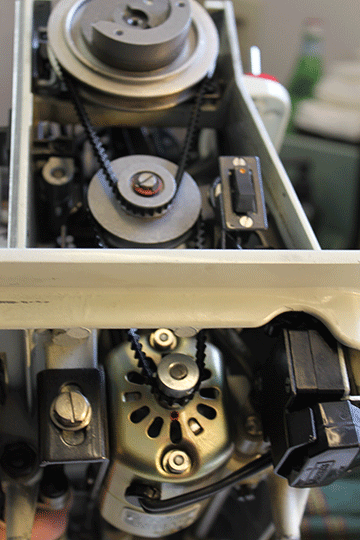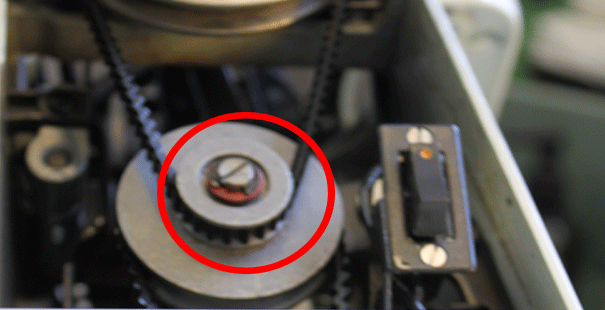I found the culprit. Stretch stitches go back and forth. So the feed dog reverse mechanism kicks in at appropriate intervals to accomplish the back motion in the stretch stitch. There is a spring that keeps the feed dogs from staying in reverse. When the spring releases and allows the mechanism to come back forward, it makes a clattery noise.
Here is a photo of the noise maker looking down into the machine
And here is one looking at it from the end and a little below.
I oiled this mechanism and ran the machine and eventually it quieted down. It sill clacks some but now it does not sound as if something is going to shatter. The magic of sewing machine oil.
This machine is belt driven. Double belts. This is a photo of the 1803. The machines are very similar and the only difference between this and the 1813 is the handwheel mechanism.
I worked on the 1803 this morning. When I was putting it away I found a nut under the machine. I thought "This cannot be good." Lucky for me I had the 1813 and I examined it and found that the nut had fallen from the screw in the bottom pulley. I thought that I needed to loosen that screw to remove the belt so I could get the handwheel off. I was wrong.
I needed to loosen the screw holding the motor in place. It is actually a slotted nut. Lucky for me I had a new socket set.
Well, no matter. I figured out where the nut belonged and put it back. In doing so, tightened up some of the play that was in that pulley. I probably caused the play by loosening the screw. But I am glad that I found the nut its home.






I was referred here from Rain at VSSMB. I like seeing all the different old machines you fix up in addition to the antique models. Do you have any sort of recommendations for someone (me) who wants a sturdy, reliable sewing machine?
ReplyDeleteI've tried to use the new plastic ones and they just always seem to break. I don't need five thousand fancy options. What I don't want is something that I will have to replace every few years or do a lot of maintenance on. This is what has drawn me to look for an older sewing machine because generally things made 30+ years ago are more durable.
I've looked on Craigslist, but until I know what I should be looking for it just seems like a waste of time. I would love to have some kind of "dummy guide" to some of the common older sewing machines about features, etc. Or if you know of any resources that would help me decide on a good machine, that would work, too.
Mary, These vintage Kenmores are great machines. Generally the 158 Source machines are made in Japan and are reliable and sturdy. Some are made in Taiwan but are just as good; just different features. If you don't want stretch stitches the older 158s are very nice machines. Heavy, but sturdy.
ReplyDeleteThe 158.1813 appears to have a nice selection of stitches.
ReplyDeleteNot sure how I feel about the 2 belts. Makes me think this machine wouldn't be as strong as the 158.96
But probably still a great machine for everyday sewing. I love Kenmore sewing machines!
Thanks for posting!
I have a Kenmore 158.1813 problem, The machine will not sew. I can load thread on a bobbin, pushed in the hand wheel, but the machine will not move the needle. I can manually move the hand wheel and the needle moves. The belts looked OK, but I replaced them becuase this was easy. Unfortunately I can't get the machine to sew. Also, I cannot lineup the 2 red dots on teh Stich Width Control. Several years ago I took the machine in for routine mtc and stupid me, I didn't test the machine until now. I'm thinking maybe they took the stich Width Contol off and didn't put it back in the correct position.
ReplyDeleteI'm alss looking for the schematic witht he hope that I can identify and fix the problem. All advice is much appreciated. Thanks, Mary
I love this machine. I have had it forever. It runs beautifully, and has never needed repair. It must be 40 years old. I like that it is heavy, and doesn't bounce around on the table like the lighter ones. It will sew anything with the proper needle. However, I cannot find my cording foot. Do you have any suggestions as to a good source? I'm gathering it's considered a "high shank" machine???? Sears doesn't seem to have anything useful.
ReplyDeleteI have a Kenmore 158.500 that I've used since my mom got it as a floor model in 1960. (I was in the 6th grade.) There's a sticker that instructs the user to oil the motor with one drop no more than once every six months "on the two red dots." Your photograph has FINALLY shown me where to long ago faded marks were. Thanks a million. I'd like to brag that it has never had a problem but just today the mechanism that controls the zig zag stopped working. I'm going to tinker and probably look for a repair person.
ReplyDeleteTinker first. Repair person later. Likely the zig zag mechanism is just stuck. I remember having this problem with a 158.96. I just kept oiling the mechanism and moving it by hand back and forth, 1,271 times. Sometimes applying heat with a hair dryer helps too.
DeleteI need to replace the belts on my machine (which i love and do not want to replace). I cannot get the hand wheel off in order take off the cover to get at the belts. How do i get the cover past the hand wheel?
ReplyDeleteYou must pop off the cover. Look for a small opening and then gently pry it open with a small screw driver. I think. Take my advice at your own risk.
DeleteI have an old Kenmore Sewing machine that sewed great. The belt finally here out and needs to be replaced. The belt is located behind the hand wheel which has no free area to work with. The wheel must come off to get to the upper turn of the belt. How does it come off? Do I need a puller or something? Thanks for any help.
ReplyDeleteI have a vintage Kenmore 1560. It makes a plasticky zzzzz sound which sounds like it's coming from the handwheel. I've heard this before on other vintage Kennies but I have never figured out what it is or how to fix it. Any ideas?
ReplyDeleteNope. If it doesn't affect the sewing, I wouldn't worry. It could be the belt.
DeleteSounds like you are pretty handy. Hope you can help me. I have Kenmore 1813. Went in today to do some mending, took off the presser foot that was on there. Went to put another on and the little lever wouldn't lift the rod up so I could put the foot on. That rod has a spring around it. That's where you adjust the tension up above. I've had it all apart, cleaning, oiling, looking, and only thing I can figure out is perhaps that spring needs to be replaced. I pulled it out. It looked OK, and tension seemed tight on it, I just dunno. Sure hope you have some ideas.
ReplyDeleteThanks,
Barbara
I don't have any of those accounts on "select profile", so have to post as anonymous, sorry.
I'm not so good without the machine in front of me.
DeleteAny idea how to use the needle threader that comes with the Kenmore Model 1803 machine. I have had this machine since the 1970's, still love the machine but have never been able to figure out how to use the threader.
ReplyDeleteI have a Kenmore model 1451 a.k.a. 158.1451 purchased around 1978. It has worked well. I recently purchased a Sears specified walking foot for my machine in order to do some machine quilting. It does not seem able to sew the "quilt sandwich". Long stitches alternate with extremely tiny stitches and the seam and quilt pucker despite trying all different tension settings, the longest stitch length and different pressure regulator settings. A mechanic I know suggested that it may need a new belt after all these years. Any ideas as to why the walking foot does not work?
ReplyDeleteIf your machine sews well without the walking foot, you do not need new belts. I suspect that your walking foot is the problem I have never had good luck with walking foots for Kenmores.
ReplyDeleteThat makes sense to me. Thank you, Elizabeth.
ReplyDeleteI have a question. I'm having an issue with my bobbin. It tangles and I can't seem to fix it. Also, I'm wondering what type of needle fits this machine correctly since the manual says only to use Kenmore needles. Thanks for your help!
ReplyDeleteBe sure that you are using a class 15 bobbin Be sure that you have a well wound bobbin. Be sure that you have loaded the bobbin into the bobbin case correctly and that the race and hook are free of lint and debris and well oiled.
DeleteBe sure that the needle is seated properly in the needle bar. The long grove should be in front with the scarf to the back. Or, another way to describe it, flat to the back, needle threads front to back
This machine takes any standard 15X1 or 130/705H domestic machine needle. I like Schmetz. https://www.amazon.com/SCHMETZ-Universal-Household-Machine-Needles/dp/B00A8NZSLA
I have the Kenmore 158.18033. I bought it new in 1974. Love, love, love it.
ReplyDeleteI used it last Halloween and it worked great. I tried to use it last week and somehow the bobbin winder froze up.. Well, I was able to soak it in mineral spirits and get it working, but now the machine sews, but not over heavy fabrics.....it stalls out....I can turn the handle to sew s l o w l y. I think the bobbin clutch needs fixing? Adjusting? I cannot figure out how to remove that part after I removed the handle...any ideas? I have tried to find online instructions but nothing matches up....thanks
I would suggest that you consider getting some Tri-flow lubricant and lubricate the whole machine where metal parts touch each other. Take the top off, oil in there. Oil underneath the machine as well. Take the handwheel apart and clean and oil it. Mineral spirits get sticky when they dry so you may have compounded the problem. Oil and heat and repeat often works. Good luck
DeleteTri-flow does work very well. Just requires some patience. 😊
DeleteHi
ReplyDeleteI have a kenmore model 158.18034. I got this as a wedding present from my uncle in 1977. I love it. It came in a beige carrying case and later I bought a table for it and like a fool gave away the case. Now I want to bring my machine downstairs to keep on the counter and can't find the case anywhere. If anyone can help me I would really appreciate. Thanks in advance.
You can make your own base. https://mysewingmachineobsession.blogspot.com/2012/09/sewing-machine-base.html
Delete